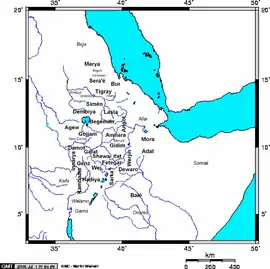Fetegar
The Sultanate of Fetegar was a medieval Muslim kingdom in the Horn of Africa established in the late 10th century.
Sultanate of Fetegar | |||||||||||
|---|---|---|---|---|---|---|---|---|---|---|---|
| 1000–1650 | |||||||||||
| Capital | Yifat | ||||||||||
| Common languages | Oromo, Hadiya, Amharic | ||||||||||
| Religion | Islam | ||||||||||
| Government | Monarchy | ||||||||||
| Sulṭān | |||||||||||
| History | |||||||||||
• Established | 1000 | ||||||||||
• Disestablished | 1650 | ||||||||||
| |||||||||||
| Today part of | Ethiopia | ||||||||||
Origins
Local tradition claims that the sultanate was a Gurage kingdom, but early Arab sources cited by Brakumper record that Oromos were already living in the area and had founded many kingdoms, one of which was Fetegar, after their conversion to Islam by Ifat.[1][2]
Location
Fetegar separated Ifat from Showa and was south of the kingdom of Lasta.[3] It is also described as having been located in eastern Ethiopia, where several kingdoms, such as Ifat, Mora, Dawaro, Hadiya and Bali, also existed.[4] The area was renamed Hararghe, Arsi Province.

History
Fetegar was founded during the arrival of Islam in Eastern Ethiopia in the early 10th century, along with other kingdoms such as Adal, Ifat, Showa, Mora and Dawaro.[5] It was a large kingdom and one of Ifat's strongest allies; the latter used it as leverage against the rest of Ethiopia, since in order to get to Ifat, the Abyssinian Empire had to go through several other kingdoms, including Fetegar. Ifat sent governors and advisors to the sultanate to lead their Muslim allies.[6]
One ruler of Fetegar, Sultan Azmach Islamo, earned his name by fighting fellow Muslims, among other notable deeds.[7] Another noted ruler was Garād, or Ras Amdu; according to one chronicle, his reputation was enough to dissuade the Abyssinians from invading Fetegar. The chronicle records this statement: "Let us also have the protection of the Muslims in order to achieve our aims, and bring them in so that our religion may not be changed. But there is a Garad (Ras) Amdu, and as long as he lives the Muslims are weak and scared. This would lead to them plotting against him they planned to spread a rumour, the rumour spread that the King slept with Queen Eleni of Abyssinia. With this the king was furious and led a Army from Wej to Fetegar, and also campaigned against Maya,. With this Amdu invaded Fetegar and several other kingdoms.,[8] and decisively defeated the Moslims however in his Campiagn the Abyssinian king Eskender came to the support of the Muslims. Eskender captured Amdu and killed him. Amdu’s nephew Welde Sulis succeeded Amdu when he met Eskender he swore a oath not to spare him.
The Muslims of Fetegar then became powerful after the end of the Zway Dynasty. The Oromos’s (Fetegar) then invaded Zway and most of the Sultanate of Ifat Fetegar would rule till the establishment of the Emirate of Harar.[9] [10]
Amdu died, leaving Fetegar weak against the attacks of the Abyssinian Emperor Amda Seyon I. He attacked the Muslim states and Fetegar fell, along with Ifat, Dewero, Bale, Waj and many others.[12]
Conquest of Abyssinia
Later, in the mid 16th century, Fetegar was invaded by the Imam of Adal , Ahmed Gurey.[13]
When he died, one of his Generals, Garad Abbas, did not follow his orders, and Fetegar was invaded by Garad Abbas and he would invade many kingdoms; however his campaign was stopped by the Emperor Gelawdewos.[14]
References
- A Journal of Oromo studys. Snippet view: Brakumper. 2008. p. 210.
- A River of blessings,Essays in Honour of Paul Baxter. Snippet view: David Brokensha,Paul Trevor William. 1994. p. 52.
- Atlas of the year,1000. John Man. 2009. p. 119. ISBN 9780674541870.
- African history from the earliest of times to independence. Snippet view: Phillip.D.Curtin. 1995.
- The Ethiopian Borderlands essays regional history from the Ancient times till the end of the 18th century. Red Sea press (Asmara Eritrea): Pankhurst. 1997.
- Borderlands. Pankhurst. p. 42.
- North East African studies. Snippet view. 1998. p. 42.
- Church and state in Ethiopia. Oxford University Clarendon press: Tadesse Tamrat. 1972. p. 286.
- Lincei, Accademia Nazionale dei (1974). Problemi Attuali. 550. pp. Snippet view.CS1 maint: location (link)
- Lincei, Accademia Nazionale dei (1974). Problemi Attuali. p. 551.
- Lincei, Accademia Nazionale dei (1974). Problemi attuali Di scienza de cultura quaderno. Snippet view. p. 549.
- Culture and customs of Ethiopia. Solomon Addis Getahun,Wudu Tafet kassu. 2014. p. 55. ISBN 9780313086069.
- The Cambridge history of Africa. Oliver. 1975. p. 172. ISBN 9780521209816.
- Ethiopian Borderlands. Library of congress: Pankhurst. 1997. p. 201.